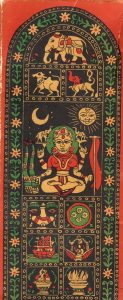
An illustration of the Mandala-brahmana Upanishad, in which the god Narayana, a form of Vishnu, teaches yoga to Yajnavalkya.
3,744 words
Part I here, Part II here, Part III here
The Brihadaranyaka Upanishad is quite long, and we can only scratch the surface here. In truth, even the shortest of the Upanishads could justify a long commentary. The texts of Vedanta are a whole, each of the parts of which reflects the whole in miniature. In other words, within each text one may find the whole teaching. This does not mean, of course, that the whole teaching is explicitly stated. Rather, one will find that to truly understand the full significance of any one statement in the Upanishads, we must situate it within the context of the entire teaching.
“Brihadaranyaka” means “of the great forest.” Aranyaka means “of the forest” or “of the wilderness.” The Aranyakas are understood to be a type of ancient Hindu literature, along with the Samhitas, the Brahmanas, and the Upanishads. (more…)





 8,304 words
8,304 words





